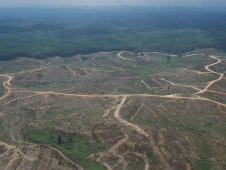
The ecological footprint of humans requires 1.5 planet earths to meet the demands being placed on it. Overall, we are losing between 0.5–1.5% of wild nature (natural habitats and species populations) each year, with losses in tropical forests considerably higher. We are thus compromising the biodiversity that maintains biological productivity and ecosystem services, on which we and future generations depend.
There are more than 7.3 billion people in the world, a figure that is increasing by c.83 million per year (United Nations 2015). To be sustainable in the long term, humanity’s consumption of renewable natural resources must stay within the limits of the Earth’s biological capacity. Consumption depends on the number of consumers and the amount each consumes; capacity depends on the efficiency of production systems. Estimates of our use of the biosphere—the area needed for growing crops, grazing animals, harvesting timber, fishing, accommodating infrastructure and sequestering the carbon released by burning fossil fuels—show that we are living unsustainably (Wackernagel et al. 2002, Loh 2002). By 1999, humans were already using 120% of the Earth’s long-term productive capacity (Wackernagel et al. 2002), and by 2010 this figure had risen to 150% (WWF 2014). This ecological ‘footprint’ is larger in high-income countries than in low-income ones (WWF 2014)—reflecting the fact that the richest 20% of the world accounts for 86% of material consumption (UNEP 2002), while over 800 million people remain in extreme poverty (World Bank Group 2016).
These pressures are causing rapid biodiversity loss. Data are still very inadequate, but the best estimates are that we are losing between 0.5–1.5% of wild nature (natural habitats and species populations) each year (Balmford et al. 2003, Jenkins et al. 2003). Some habitat types, such as temperate forests, are increasing in area, but these are exceptional. For example, loss of moist tropical forest (the primary reservoir of terrestrial species diversity) was c.0.4% per year from 1990–1997, with another 0.2% ‘visibly degraded’ (Achard et al. 2002). Population losses for vertebrate species in this habitat were considerably higher, at 1.1% per year between 1970 and 1999, probably reflecting high levels of exploitation for food (Balmford et al. 2003). The Living Planet Index (an index measuring trends of thousands of vertebrate species) shows population size declines of 52% between 1970 and 2010 (WWF 2014), and declines of 49% in marine populations between 1970-2012 (WWF 2015) emphasizing the rapid losses being experienced across land and sea.
A loss of 1.5% per year may not seem like much. Over a human generation, however, this adds up to roughly a third of what is remaining (Balmford et al. 2003)—and we have already cleared around half the world’s natural habitats (Jenkins et al. 2003). We are thus compromising the biodiversity that maintains biological productivity and ecosystem services, on which we and future generations depend.
References
Compiled: 2004 Last updated: 2016
Recommended Citation:
BirdLife International (2016)
Human impacts on the planet are growing—to the extent that we are compromising our own future.
Downloaded from https://datazone.birdlife.org/sowb/casestudy/human-impacts-on-the-planet-are-growing—to-the-extent-that-we-are-compromising-our-own-future on 23/12/2024